

You are the smartphone company’s project head. Your new phone, with great features, a sleek look, and a high-quality camera, didn’t sell well after the launch. And even the customers started showing dissatisfaction.
So, to address this crisis, you decided to conduct a product survey, with the help of an efficient product feedback platform, to understand your customers’ experiences and reasons for declining sales and dissatisfaction with your smartphone. The survey revealed several crucial insights:
- Many respondents complained about the poor battery life of the smartphone.
- Users reported dissatisfaction with the camera quality.
- The lack of timely software updates and bug fixes.
- Users were actively complaining about it on social media.
Armed with this product feedback, you took immediate action. You invested in improving battery technology, upgraded the camera features, and committed to more frequent software updates. You also introduced a loyalty program to retain existing customers. And ensure that dedicated support is given over social channels as well. Over the next year, the results were remarkable:
- Customer satisfaction increased significantly.
- Sales started to rebound as users appreciated the product improvements.
- Regained your reputation as an innovative and customer-centric brand.
This shows how product surveys can be a lifeline for businesses. They provide essential data that guides product development and helps companies stay attuned to customer preferences – ensuring their products remain competitive and well-received in the market.
This is why it is important to understand what is a product survey, its types, and what are the important product survey questions to ask to get maximum value. So, let’s start this blog by understanding what is a product survey.
Different Types of Product Survey Questions
12+ Product Survey Questions Examples
What is a Product Survey?
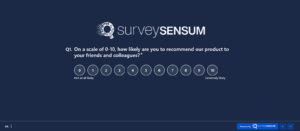 A product survey is used by businesses to gather feedback, from their customers about a particular product or service. The goal of a product survey is to gain insights into various aspects of the product, such as its usability, features, design, and overall customer satisfaction.
A product survey is used by businesses to gather feedback, from their customers about a particular product or service. The goal of a product survey is to gain insights into various aspects of the product, such as its usability, features, design, and overall customer satisfaction.
They are an essential tool for businesses for several reasons, such as:
- They allow you to gather product feedback from your customers. This feedback is invaluable in understanding their needs, preferences, and pain points.
- They help you identify product defects or areas that need improvement.
- They help you prioritize which features to work on first.
- They are used to gauge customer loyalty and satisfaction.
- You can use surveys to assess market interest and gather insights on pricing, customer preferences, etc.
- By asking customers about their experiences with competitors’ products, you can gain insights into your competition’s strengths and weaknesses.
Now that we know what is a product survey and why it is important, let’s now know the different types of product feedback surveys.
Different Types of Product Survey Questions
 1. Open-ended Questions
1. Open-ended Questions
These types of product survey questions allow your respondents to provide detailed feedback. They are useful for gathering in-depth, qualitative feedback.
Example: ‘What specific features would you like to see in our next product update?’
 2. Closed-Ended Questions
2. Closed-Ended Questions
Closed-ended questions offer predefined answer options, making it easier to quantify and analyze responses.
Example: ‘What aspect of the new app do you like the most?’
A) Filtering option B) Categorization C) Product availability D) Other (please specify).’
 3. Rating Questions
3. Rating Questions
These questions use numerical scales for measurement and are used to gauge customer satisfaction and preference.
There are 3 types of rating scale question type you can use:
- Multiple Choice: ‘Which of the following features do you use the most?’
- Yes/No: ‘Have you ever recommended our product to others?’
- Likert Scale: ‘On a scale of 1 to 5, how satisfied are you with our product?’
 4. Ranking Questions
4. Ranking Questions
This question type asks respondents to prioritize a list of items based on their importance or preference which helps you understand which product features are most important to your customers.
This information is valuable for product development and enhancement.
Example: ‘Please rank the following product attributes from the most important (1) to least important (5).
Price, Performance, Durability, Design, Customer Support.’
 5. Matrix Questions
5. Matrix Questions
Ranking questions ask respondents to prioritize a list of items based on their importance or preference.
By knowing how customers rank different aspects of your product, you can customize your offerings to align more closely with their preferences.
Example: ‘Please rate the following aspects of our product on a scale of 1 to 5:
(1) Quality, (2) Ease of Use, (3) Reliability, (4) Value for Money.’
Launch Your First Product Feedback Survey – Sign Up Now
We have now understood the different product survey question types, let’s now explore some product survey questions that you can use in your next product survey.
12+ Product Survey Questions Examples
Now that we know what is a product survey and the different types of product survey questions, let’s go through some important product survey questions.
1. On a scale of 1 to 10, how satisfied are you with our product?
Scale: 1 (Extremely Dissatisfied) to 10 (Extremely Satisfied)
Why: This provides a numeric representation of overall satisfaction, allowing for precise measurement and easy comparison.
2. How likely are you to recommend this product to friends and colleagues?
Scale: 1 (Not at all likely) to 10 (Extremely likely)
Why: To measure customer advocacy and their likelihood to recommend the product.
3. How often do you use our products?
Scale: Multiple-choice – Select from options such as ‘Daily,’ ‘Weekly,’ ‘Monthly,’ ‘Rarely,’ ‘Never.’
Why: This helps gauge product usage frequency and customer engagement.
4. Which features are most valuable to you?
Scale: Multiple-choice – respondents can select the most valuable features from a predefined list.
Why: This identifies the features that matter most to customers, aiding in feature prioritization.
5. How would you compare our products to our competitors’?
Scale: 1 (Far Inferior) to 5 (Neutral) to 10 (Far Superior).
Why: This assesses perceived product quality in comparison to competitors.
6. What’s one feature you’d like us to add?
Open-ended question.
Why: Allows customers to provide specific feedback on desired improvements.
7. How would you describe our product?
Open-ended question.
Why: Gathers qualitative insights into how customers perceive your product, helping with branding and messaging.
8. What are you trying to solve by using our product?
Open-ended question.
Why: Helps you understand the specific problems or needs your product addresses.
9. What other types of people could find our product useful?
Open-ended question.
Why: Offers insights into potential customer segments and marketing opportunities.
10. How easy is it to use our product?
Scale: 1 (Very Difficult) to 5 (Neutral) to 10 (Very Easy)
Why: Assesses user-friendliness and usability of the product.
11. How would you rate the value for money?
Scale: 1 (Poor) to 5 (Average) to 10 (Excellent)
Why: Evaluate the perceived value and cost-effectiveness of the product.
12. How could we improve our product to better meet your needs?
Open-ended question.
Why: Encourages customers to suggest improvements and provides actionable feedback for product development.
There you go! 12+ product survey questions covering every aspect of your customer experience. Let’s now jump to some tips that you can implement while asking product survey questions.
Top 6 Tips for Asking Product Survey Questions
Here are some tips that you can use to create impactful product feedback surveys.
- Define Purpose or Objective: Clearly define the purpose or objective of your survey. What do you want to learn or achieve? Understanding your goals helps shape your questions.
- Ask Relevant Questions Only: Avoid unnecessary or off-topic questions. Ensure that every question directly contributes to your survey’s objectives. This keeps the survey concise and focused.
- Incorporate Both Closed-Ended and Open-Ended Questions: Use a mix of closed-ended (multiple-choice, rating scales) and open-ended questions. Closed-ended questions provide structured data, while open-ended questions yield qualitative insights.
- Use Simple Language: You can utilize a reworder to keep the language clear, concise, and easily understandable. It also assists in avoiding jargon or technical terms that may confuse your customers.
- Don’t Mislead the Respondent: Avoid biased or leading questions that push respondents toward a particular answer. Questions should be neutral and unbiased to gather honest feedback.
- Close the Feedback Loop: After collecting and analyzing survey responses, share the results with your customers. Let them know how their feedback is being used to make improvements. Closing the feedback loop fosters trust and demonstrates that their opinions are valued.
Conclusion
Product survey questions provide valuable insights into your customer’s needs and preferences, helping your product stand out in a competitive market. So, the above list of 12+ survey questions covers everything from product satisfaction to competitive analysis, ensuring a comprehensive understanding of your customers’ experiences and satisfaction with your product.
But creating the best product feedback survey isn’t enough, for effective feedback management, investing in a platform like SurveySensum is crucial. This platform helps you launch customizable surveys, and track and analyze the survey results in real-time – enabling you to resolve issues promptly.
FAQs
The 5 types of product survey questions are – multiple-choice, rating scale, open-ended, binary, and ranking questions.
In a product survey, consider asking questions like:
- Satisfaction: ‘How satisfied are you with our product on a scale of 1 to 5?’
- Usage: ‘How often do you use our product?’
- Feature Prioritization: ‘Which features are most valuable to you?’
- Recommendation: ‘On a scale of 1-5, how likely are you to recommend our product to others?’
- Improvements: ‘What’s one feature you’d like us to add?’
To create a good product survey:
- Clearly outline your goals and what you want to learn.
- Include different question types like multiple choice, rating scales, open-ended, and relevant questions.
- Limit the number of questions and keep it concise.
- Use simple language and ensure it’s user-friendly.
- Test the survey with a small group before deploying it to a larger audience.
A product satisfaction survey is a type of product survey used to assess customers’ contentment with a product or service. It includes questions related to overall satisfaction, specific features, user experience, and suggestions for improvement. It helps businesses to gauge customer happiness and identify areas for improvement.
Good product survey questions include inquiries about overall satisfaction, feature usage, recommendations to others, specific likes or dislikes, and suggestions for improvement. It should also have different question types like multiple choice, open-ended, etc.






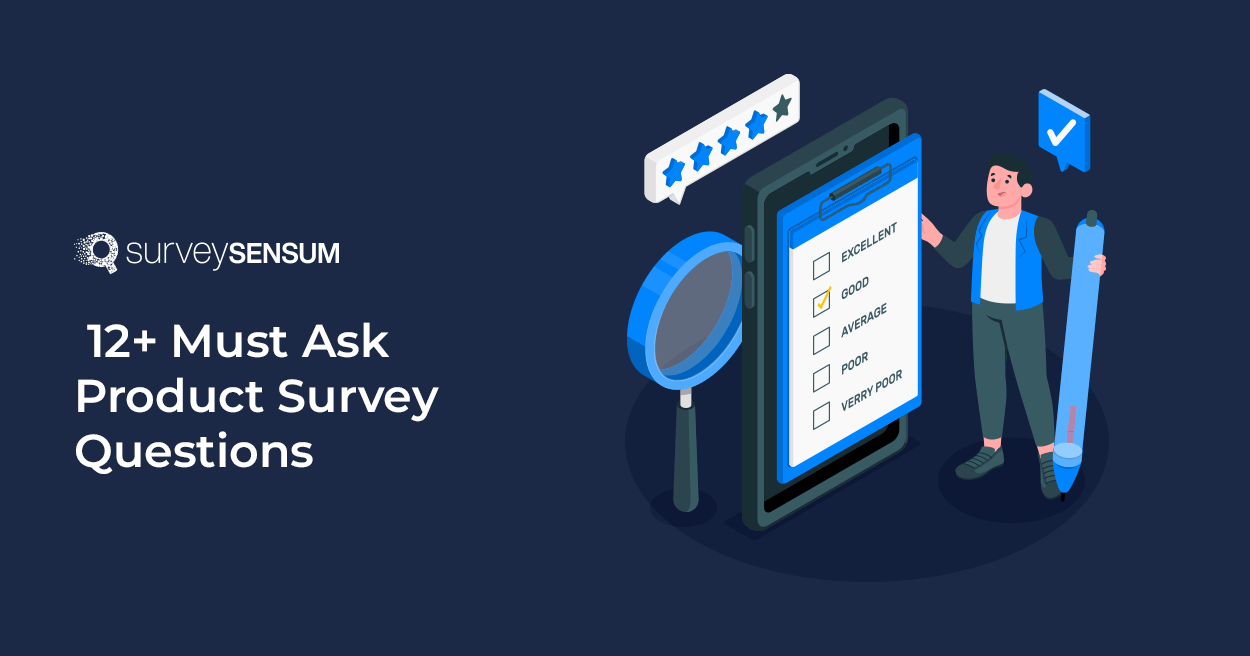
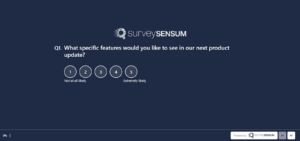 1. Open-ended Questions
1. Open-ended Questions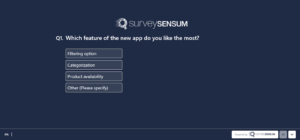 2. Closed-Ended Questions
2. Closed-Ended Questions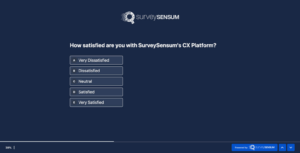 3. Rating Questions
3. Rating Questions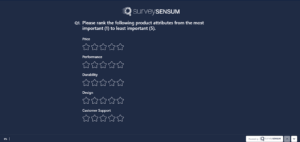 4. Ranking Questions
4. Ranking Questions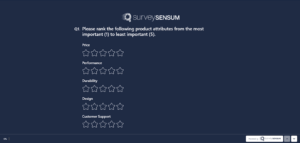 5. Matrix Questions
5. Matrix Questions







